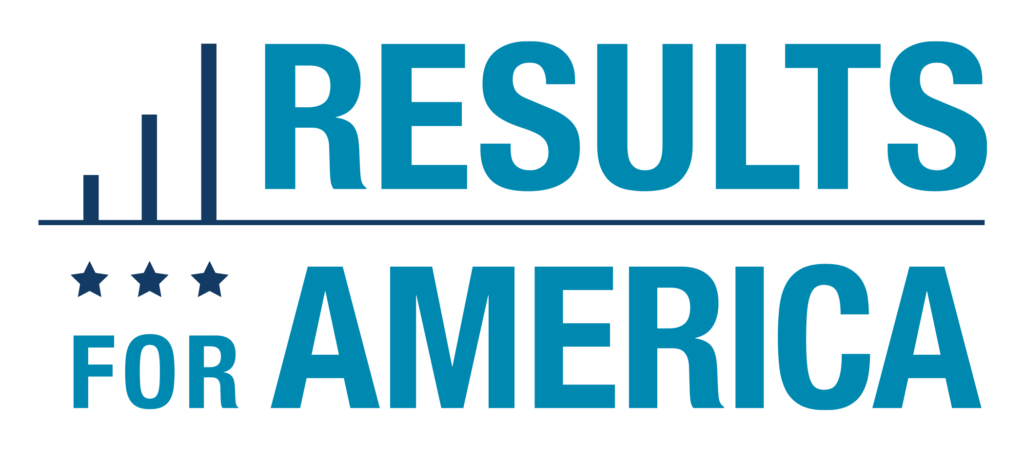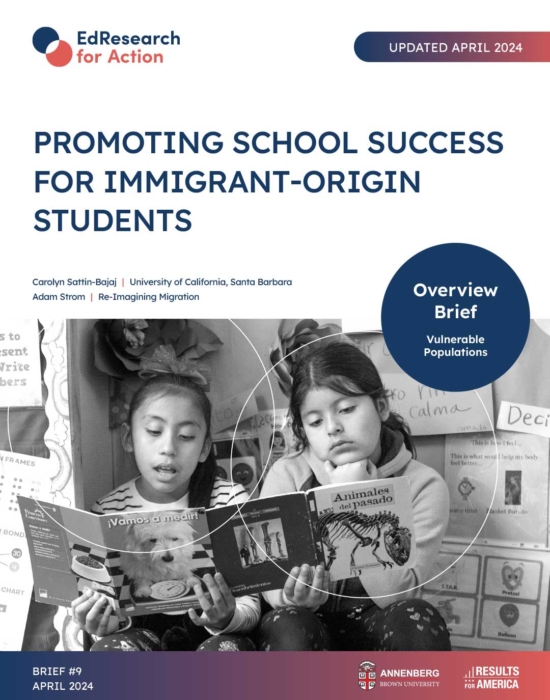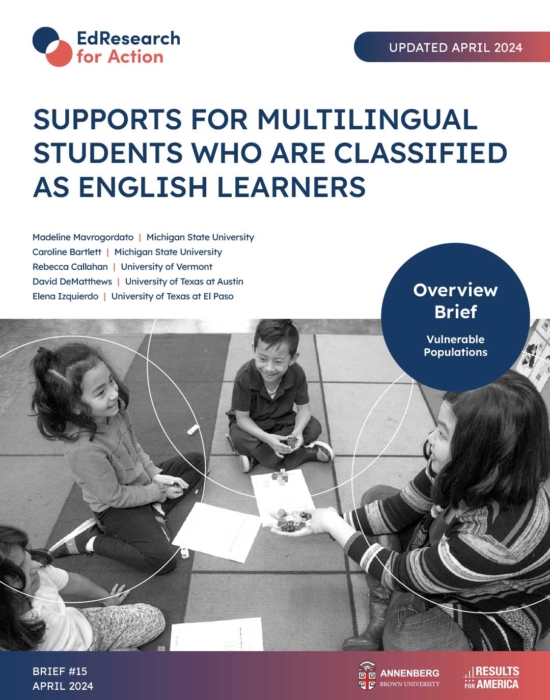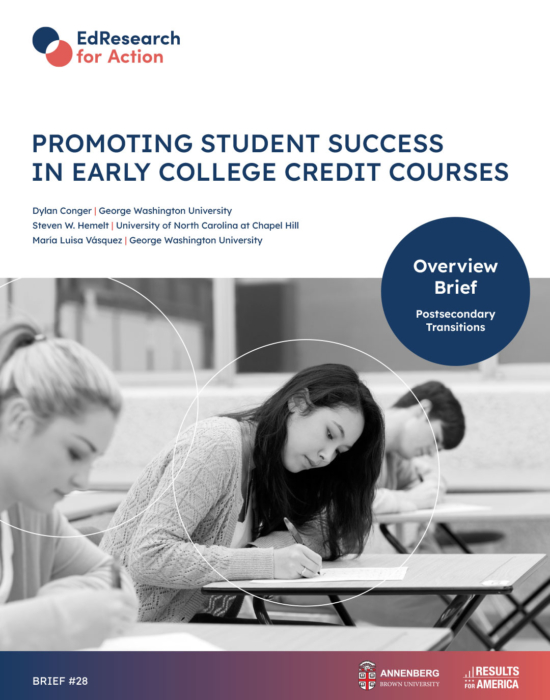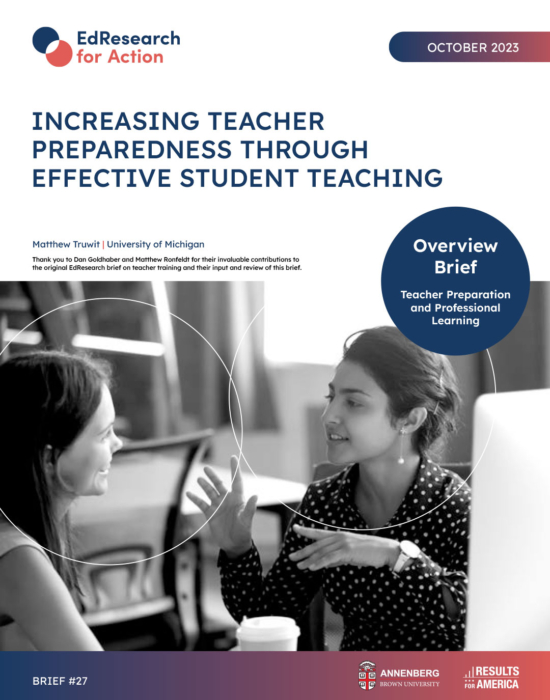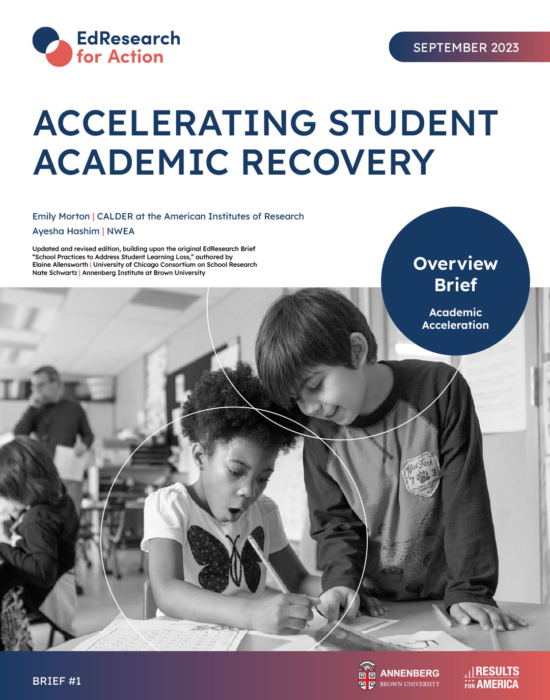PROMOTING STUDENT SUCCESS IN EARLY COLLEGE CREDIT COURSES
The EdResearch for Action Overview Series summarizes the research on key topics to provide K-12 education decision makers and advocates with an evidence base to ground discussions about how to best serve students. Authors – leading experts from across the field of education research – are charged with highlighting key findings from research that provide concrete, strategic insight on persistent challenges sourced from district and state leaders.
Dylan Conger | George Washington University
Steven W. Hemelt | University of North Carolina at Chapel Hill
María Luisa Vásquez | George Washington University
February 2024 | Brief No. 28
Central Question
How can districts and states promote equitable success in academic early college credit courses?
Note: This brief covers research on early college credit courses that focus on academic and general content as opposed to career and technical education (CTE).
Key Insights
Breaking Down the Issue
- Over the past few decades, opportunities for students to take college courses while still in high school have grown substantially. Such early college credit (ECC) courses differ along multiple dimensions.
- Student enrollment in ECC opportunities has increased in recent decades with several state and federal policy initiatives aimed at further expansion.
Strategies to Consider
- For many students, academic ECC courses generate positive outcomes, including increased academic achievement, increased college enrollment, altered college choices, and reduced time to bachelor’s degree completion.
- At the same time, students with low levels of prior academic preparation and fewer supports are far less likely to benefit from academic ECC courses and earn college credit than those with more resources and greater preparation.
- Fee waivers for students, incentives for teachers and students, as well as systems that emphasize proactive advising about ECC opportunities increase participation among students who have traditionally faced barriers to enrollment.
- There is limited rigorous research on how to reduce inequality in outcomes, specifically within academic ECC courses; however, providing additional, ongoing supports to students and teachers, as well as using curricula that emphasize project-based learning, may help to promote equitable success.
Strategies to Avoid
- Policies that only promote access to academic ECC courses without providing additional supports to students and teachers will likely lead to greater inequality in outcomes, especially between students with different levels of out-of-school support.
Breaking Down the Issue
What are early college credit courses?
Over the past few decades, opportunities for students to take college courses while still in high school have grown substantially. Such early college credit (ECC) courses differ along multiple dimensions:
- Who develops the course (i.e., public institutions or other nonprofit organizations);
- Who teaches the course (i.e., high school teacher or college instructor);
- Where the course is offered (i.e., high school, college campus, or online);
- The focal content of the course (i.e., academic/general or CTE);
- The process for earning and articulating college credit (e.g., credit by exam versus credit by course grade), the nature of any college credits earned (i.e., remedial or nonremedial, degree-bearing), and the portability of those credits (i.e., redeemable at one institution, throughout a state, or across the country).
The terminology used to refer to different ECC opportunities varies across states, districts, and schools. Generally, ECC coursework fits into one of the following three categories:
- Advanced Placement (AP) offers courses that are developed and certified by a nonprofit organization, taught by high school teachers on high school campuses, and offer the opportunity to earn college credit through exam scores.
- Dual-enrollment programs typically allow students to take college courses at a local community college or university while still enrolled in high school. Students can earn college credit for passing the course. Dual-enrollment programs often include both academic and CTE courses and are developed through partnerships between local K-12 and postsecondary institutions.
- Other forms of ECC coursework that do not fit cleanly into—or blend—the prior two categories are often grouped under the term dual-credit programs. In some cases, “dual credit” refers to all ECC opportunities available to students in a state or locality; in others, dual-credit programs refer to specific forms of ECC coursework, such as those that resemble the AP approach by offering courses within high schools and awarding college credit with an exam score or those that award credit in a manner more similar to dual-enrollment programs (i.e., on the basis of a passing course grade).
Though less common, ECC courses can also be embedded in larger structures. For example, early college high schools are full-time high schools that offer a combination of high school and college courses and often include comprehensive supports. Students can earn a high school diploma and an associate’s degree or other college credit. Similarly, the International Baccalaureate program is a connected, multi-course curriculum focused on global awareness and project-based learning. This brief does not focus on these broader programs.
This resource by the Education Commission of the States provides a comprehensive overview of dual-enrollment policies in all states, offering information on program basics, access, courses, portability of college credit, and costs.
Who enrolls in early college credit courses?
Student enrollment in ECC opportunities has increased in recent decades with several state and federal policy initiatives aimed at further expansion.
- The number of high school graduates taking at least one AP exam has risen from around 452,000 in 2002 to over 1.1 million in 2022, representing approximately one-third of all high school graduates in the U.S.
- Over a similar period, the number of high school students taking dual-enrollment courses at community colleges has increased markedly. Data from the American Association of Community Colleges found that the number of part-time students under the age of 18 grew from 287,000 in 2001 to over 773,000 by 2017—a 170% surge.
- As of 2017-18, approximately 80% of high schools offered at least one dual-enrollment course.
Despite this overall enrollment growth, gaps in ECC access and participation persist. Larger schools are more likely to offer ECC courses than smaller schools, and schools in high-poverty areas are less likely to offer ECC courses than schools in low-poverty areas. Access to ECC opportunities also varies by rurality, with schools in rural and urban areas less likely to offer some forms of ECC courses than schools in suburban areas.
When available, higher-income, white, and Asian students are more likely to enroll in academic ECC courses than other students. In systems that offer both academic and CTE dual-enrollment programs, sometimes the demographic gaps in dual-enrollment participation appear smaller because Black and Hispanic students are overrepresented in CTE courses.
Research that examines explanations for these disparities in academic ECC course participation often points to the cost associated with credit articulation, prior academic preparation, and supports as leading explanations. Additional barriers to boosting ECC course offerings include the limited availability of well-prepared teachers, particularly in nonurban areas, as well as concerns about the quality and rigor of some forms of ECC courses when compared to their postsecondary analogs.
Strategies to Consider
There is a growing body of research on the effects of participation in academic ECC courses on students’ subsequent outcomes. However, the evidence is too thin to draw comparisons between the different types of academic ECC courses (e.g., AP versus dual-enrollment). Taken together, the collection of studies suggests the following key findings:
For many students, academic ECC courses generate positive outcomes, including increased academic achievement, increased college enrollment, altered college choices, and reduced time to bachelor’s degree completion.
- Experimental evidence indicates that taking AP courses can increase students’ skills in the subject and motivation during high school.
- Another randomized controlled trial found that dual-credit math coursework can lead to increased participation and success in additional ECC math courses, such as AP courses, later in high school.
- Participating in AP courses can boost students’ aspirations to attend more selective institutions.
- Taking dual-enrollment courses can increase the likelihood that students are accepted at a highly selective four-year college and increase the likelihood that they enroll in a four-year college; taking dual-credit courses can induce middle-achieving students to choose four-year universities over two-year colleges.
- Students who succeed in dual-enrollment courses and subsequently enroll in college may experience higher levels of motivation and better first-semester grades than students who do not succeed in such courses.
- Students who enroll in college with credit-bearing scores on AP exams earn their bachelor’s degrees more quickly than students who enroll in college and who take but do not earn credit-bearing scores on AP exams.
At the same time, students with low levels of prior academic preparation and fewer supports are far less likely to benefit from academic ECC courses and earn college credit than those with more resources and greater preparation.
- One state successfully broadened access to dual-credit courses for students with wider ranges of prior preparation. However, the pass rates on the exams necessary to secure college credit were close to zero for students who enrolled in the courses with low levels of academic readiness.
- A recent study in another state failed to find benefits for most students—in terms of college enrollment or degree completion—of increases in the number of AP courses available at their high schools. Only students who entered high school with strong academic preparation experienced small positive effects on college enrollment or degree completion from additional AP course availability.
- A recent study found that adjusting for measures of prior academic achievement (including grades and test scores) substantially reduced, and in some cases eliminated, racial and ethnic gaps in the likelihood of earning a college-credit-bearing score on an AP exam.
- An experimental study across 23 schools new to offering AP courses found that the demanding workload and high expectations in AP science classes reduced students’ confidence in their ability to succeed in college-level science and increased stress levels. Many teachers also expressed challenges in implementing the AP curriculum and delivering college-level rigor due to varying levels of student preparation.
Fee waivers for students, incentives for teachers and students, as well as systems that emphasize proactive advising about ECC opportunities increase participation among students who have traditionally faced barriers to enrollment.
- Districts or states that offer fee reductions or waivers for low-income students to enroll in AP or dual-enrollment courses have smaller gaps in participation by race than states with no such financial incentives, suggesting that state policies that remove financial barriers may reduce enrollment disparities.
- AP exam fee exemptions may boost rates of exam-taking among students enrolled in AP courses, especially for those from low socioeconomic backgrounds.
- One study of schools in Texas found that Black and Hispanic student enrollment in AP courses increased substantially when schools introduced incentives for both teachers and students. The Advanced Placement Incentive Program (APIP) provided annual salary supplements to lead AP teachers for curriculum development and training other AP teachers and provided cash incentives to teachers and students for passing scores on AP exams. The program also paid half of each student’s AP exam fees.
There is limited rigorous research on how to reduce inequality in outcomes, specifically within academic ECC courses; however, providing additional, ongoing supports to students and teachers, as well as using curricula that emphasize project-based learning, may help to promote equitable success.
- Research-based practices that support students who have fallen behind academically, including high-dosage tutoring, extended learning time, early monitoring of progress, and well-trained guidance counselors are likely to promote the success of students with lower levels of prior preparation in academic ECC courses.
- In one state that created new statewide dual-credit courses, course-specific online groups for high school teachers improved teacher engagement and facilitated the sharing of ideas and strategies. More broadly, students are likely to succeed in courses taught by teachers who have supportive instructional coaching.
- Some case studies suggest that providing additional supports that socialize students to the nonacademic aspects of college to low- and middle-achieving students who enroll in academic ECC courses may improve student success. For instance, collaborations between secondary and postsecondary faculty that lead to college-going activities and counseling may boost knowledge and success. However, there is scant evidence of the direct impact of these practices on student success metrics in academic ECC courses.
- A recent experimental study found that students from high- and low-income backgrounds achieved higher AP exam scores in AP courses that emphasized project-based learning. These courses focused less on memorization and lectures and focused more on student-driven inquiry and the teacher as facilitator compared to AP courses that relied on traditional lecture-based approaches.
Strategies to Avoid
Policies that only promote access to academic ECC courses without providing additional supports to students and teachers will likely lead to greater inequality in outcomes, especially between students with different levels of out-of-school support.
- A recent study in Michigan showed that when schools increase AP course offerings, existing gaps in course participation rates widen. Higher-income students, white and Asian students, and students with higher academic preparation are more likely to take advantage of these courses when they are offered.
References
An, B. P. (2012). The Influence of Dual Enrollment on Academic Performance and College Readiness: Differences by Socioeconomic Status. Research in Higher Education, 54(4), 407–432. https://doi.org/10.1007/s11162-012-9278-z
An, B. P. (2015). The Role of Academic Motivation and Engagement on the Relationship between Dual Enrollment and Academic Performance, The Journal of Higher Education, 86:1, 98-126, DOI: 10.1080/00221546.2015.11777358
Britton, T., Chelliah, B., Symns, M., & Campbell, V. (2019). College Now…or Later: Measuring the Effects of Dual Enrollment on Postsecondary Access and Success. https://edworkingpapers.com/sites/default/files/ai19-118.pdf
Conger, D., Kennedy, A. I., Long, M. C., & McGhee, R. (2019). The Effect of Advanced Placement Science on Students’ Skills, Confidence and Stress. Journal of Human Resources, 56(1), 0118-9298R3. https://doi.org/10.3368/jhr.56.1.0118-9298r3
Conger, D., Long, M. C., & McGhee, R. (2021). Advanced Placement and Initial College Enrollment: Evidence from an Experiment. Education Finance and Policy, 18(1), 1–46. https://doi.org/10.1162/edfp_a_00358
Dual/Concurrent Enrollment 2022 – Education Commission of the States. (n.d.). Reports.ecs.org. Retrieved January 30, 2024, from https://reports.ecs.org/comparisons/dual-concurrent-enrollment-2022
Early Colleges as a Model for Schooling. (n.d.). Harvard Education Press. Retrieved January 30, 2024, from https://hep.gse.harvard.edu/9781682537596/early-colleges-as-a-model-for-schooling/
Ewing, M., & Wyatt, J. (2023). Understanding Racial/Ethnic Gaps in AP ® Exam Performance. https://research.collegeboard.org/media/pdf/Understanding_Racial_Ethnic_Performance_Gaps_in_AP_Exam_Scores.pdf
Gagnon, D., Lui, J., & Cherasaro , T. (2021). A Publication of the National Center for Education Evaluation and Regional Assistance at IES – Understanding Access to and Participation in Dual Enrollment by Locale and Income Level. https://files.eric.ed.gov/fulltext/ED612869.pdf
Jackson, C. K. (2010). A Little Now for a Lot Later. Journal of Human Resources, 45(3), 591–639. https://doi.org/10.3368/jhr.45.3.591
Jeong, D. W. (2009). Student Participation and Performance on Advanced Placement Exams: Do State-Sponsored Incentives Make a Difference? Educational Evaluation and Policy Analysis, 31(4), 346–366. https://www.jstor.org/stable/25621590
Hemelt, S. W., Schwartz, N. L., & Dynarski, S. M. (2020). Dual-Credit Courses and the Road to College: Experimental Evidence from Tennessee. Journal of Policy Analysis and Management, 39(3), 686-719. https://doi.org/10.1002/pam.22180
Hemelt, S. W., & Swiderski, T. (2021). College Comes to High School: Participation and Performance in Tennessee’s Innovative Wave of Dual-Credit Courses. Educational Evaluation and Policy Analysis. https://doi.org/10.3102/01623737211052310
Iatarola, P., Conger, D., & Long, M. C. (2017). Determinants of High Schools’ Advanced Course Offerings. Educational Evaluation and Policy Analysis. https://doi.org/10.3102/0162373711398124
K-12 EDUCATION Public High Schools with More Students in Poverty and Smaller Schools Provide Fewer Academic Offerings to Prepare for College Accessible Version Report to the Ranking Member, Committee on Education and the Workforce, House of Representatives. (2018). https://www.gao.gov/assets/700/695021.pdf
Karp, M. M., & Hughes, K. L. (2008). Supporting College Transitions Through Collaborative Programming: A Conceptual Model for Guiding Policy. Ccrc.tc.columbia.edu. https://ccrc.tc.columbia.edu/publications/college-transitions-collaborative-programming.html
Long, M. C., & Conger, D. (2019). Life on the Frontier of AP Expansion: Can Schools in Less-Resourced Communities Successfully Implement Advanced Placement Science Courses? Educational Researcher. https://doi.org/10.3102/0013189X19859593
Long, M. C., Iatarola, P., & Conger, D. (2009). Explaining Gaps in Readiness for College-Level Math: The Role of High School Courses. Education Finance and Policy, 4(1), 1–33. https://www.jstor.org/stable/educfinapoli.4.1.1
Owen, S. (2023). The Advanced Placement Program and Educational Inequality. https://edworkingpapers.com/sites/default/files/ai23-738.pdf
Piontek, M., Kannapel, P., Flory, M., & Stewart, M. (2016, June). The Implementation of Dual Credit Programs in Six Nonurban Kentucky School Districts. Ies.ed.gov. https://ies.ed.gov/ncee/rel/Products/Region/appalachia/Publication/3744
Rodriguez, O., & Gao, N. (2021, October). Dual Enrollment in California. Public Policy Institute of California. https://www.ppic.org/publication/dual-enrollment-in-california/
Saavedra, A. R., Lock Morgan, K., Liu, Y., Garland, M. W., Rapaport, A., Hu, A., Hoepfner, D., & Haderlein, S. K. (2022). The Impact of Project-Based Learning on AP Exam Performance. Educational Evaluation and Policy Analysis. https://doi.org/10.3102/01623737221084355
Smith, J., Hurwitz, M., & Avery, C. (2017). Giving College Credit Where It Is Due: Advanced Placement Exam Scores and College Outcomes. Journal of Labor Economics, 35(1), 67–147. https://doi.org/10.1086/687568
Troutman, D., Hendrix-Soto, A., Creusere, M., & Mayer, E. (2018). Dual Credit and Success in College. https://utsystem.edu/sites/default/files/documents/ut-system-reports/2018/dual-credit-and-success-college/utsystem-dualcreditstudy.pdfXu, D., Solanki, S., & Fink, J. (2021). College Acceleration for All? Mapping Racial Gaps in Advanced Placement and Dual Enrollment Participation. American Educational Research Journal, 58(5), 000283122199113. https://doi.org/10.3102/0002831221991138



